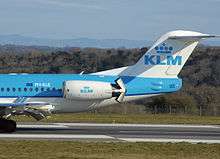TAM Transportes Aéreos Regionais Flight 402
 PT-MRK, the aircraft involved in the accident at the same airport on March 14, 1996, 7 months prior to the crash. | |
| Mechanical failure summary | |
|---|---|
| Date | 31 October 1996 |
| Summary | Mechanical failure; uncommanded deployment of thrust reverser after takeoff |
| Site | São Paulo, Brazil |
| Passengers | 90 |
| Crew | 6 |
| Fatalities | 99 (all on board, plus 3 on the ground) |
| Survivors | 0 |
| Aircraft type | Fokker 100 |
| Operator | TAM Transportes Aéreos Regionais |
| Registration | PT-MRK |
TAM Transportes Aéreos Regionais Flight 402 was a scheduled domestic flight from Congonhas-São Paulo International Airport in São Paulo, Brazil to Recife International Airport in Recife via Santos Dumont Airport in Rio de Janeiro. On 31 October 1996, at 08:27 (UTC-3), the starboard engine of the Fokker 100 operating the route had an uncommanded thrust reverser deployment while the aircraft was climbing away from the runway at Congonhas. The aircraft stalled and rolled beyond control to the right, then struck two buildings and crashed into several houses in a heavily populated area only 25 seconds after takeoff. All 96 people on board were killed, as well as another 3 on the ground. It is the fourth deadliest accident in Brazilian aviation history, the second at the time.[1]
Aircraft
The aircraft involved was a Fokker 100 with the registration PT-MRK. The aircraft made its first flight on 8 February 1993 and was acquired second-hand by TAM Transportes Aéreos Regionais in April 1995; it had accumulated more than 8,000 flying hours. It wore a special promotional blue livery on its fuselage with the inscription "Number 1", in reference to TAM being awarded "Regional Airline of the Year" by Air Transport World magazine.
Cause

The Fokker 100 aircraft incorporates a safety system to deal with an accidental deployment of a thrust reverser on take-off or when in flight; the system automatically moves the thrust control of the affected Rolls-Royce Tay 650-15 engine to reduce power, the aeroplane then being capable of climbing out safely on the full power of the one unaffected engine, or of maintaining normal flight at reduced power. In addition, a micro-switch, activated by the aircraft's main landing gear leaving the ground, disables the thrust reverser operating circuitry, preventing inadvertent operation of the thrust reverser in flight.
As the aircraft lifted off the runway on the accident flight with both engines at full power, a faulty micro-switch in conjunction with a possible short circuit caused the right engine's thrust reverser to deploy. The imbalance of power resulted in the aircraft rolling and veering to the right as it was climbing away from the runway. The copilot, seeing the starboard engine power lever automatically move to the closed position, thought that the lever had slipped back and pushed it back to the full power position alongside the left engine throttle lever. Once again, the automatic safety system closed the right engine throttle and the captain, who was conducting the takeoff, called for the autothrottle system to be switched off. After switching off the system, the copilot again pushed the right engine power lever fully forward and forcefully held it there.
The safety system cable, responsible for pulling the power lever to the idle position, no longer able to withstand the physical strain of being pulled one way by the actuator, and being pulled the other way by the throttle lever being forced to the fully open position, parted at a maintenance connection. With the lever no longer restrained by the safety system, the copilot continued to hold the right throttle fully open. The combination of the right engine at full thrust in reverse and the left engine still at normal forward take-off thrust, caused the aircraft to descend into the ground.
In the subsequent investigation it was discovered that the flight crew had not been trained for such an occurrence as the aircraft's manufacturer, Fokker, had judged the failure mode to be so remote a possibility that training for recovery was not necessary.
Dramatization
The crash was featured in the 15th season of the television documentary series Mayday. It first aired on 15 February 2016 and is titled "Carnage in São Paulo".
See also
- TAM Airlines Flight 3054, an accident that took place while landing at Congonhas.
- Lauda Air Flight 004, an accident involving in-flight thrust reverser deployment.
References
External links
- Accident description at the Aviation Safety Network
- Reproduction animation of TAM Linhas Aéreas Flight 402
- Image of the Number 1 Livery from Airliners.net
Coordinates: 23°38′46″S 46°38′51″W / 23.64611°S 46.64750°W